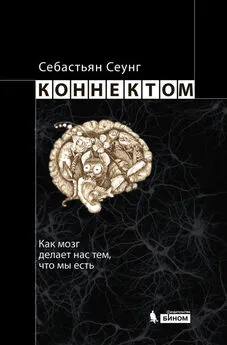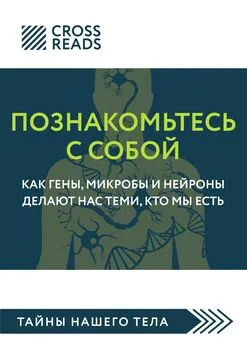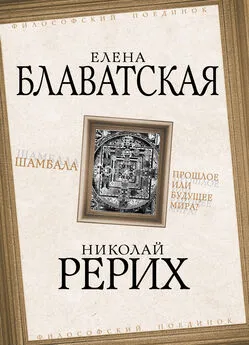Алан Джасанов - Мозг: прошлое и будущее [Что делает нас теми, кто мы есть]
- Название:Мозг: прошлое и будущее [Что делает нас теми, кто мы есть]
- Автор:
- Жанр:
- Издательство:Литагент АСТ
- Год:2019
- Город:Москва
- ISBN:978-5-17-117010-3
- Рейтинг:
- Избранное:Добавить в избранное
-
Отзывы:
-
Ваша оценка:
Алан Джасанов - Мозг: прошлое и будущее [Что делает нас теми, кто мы есть] краткое содержание
Мозг: прошлое и будущее [Что делает нас теми, кто мы есть] - читать онлайн бесплатно ознакомительный отрывок
Интервал:
Закладка:
109
D. Li, C. Agulhon, E. Schmidt, M. Oheim, and N. Ropert, «New tools for investigating astrocyte-to-neuron communication», «Frontiers in Cellular Neuroscience» 7 (2013): 193.
110
J. O. Schenk, «The functioning neuronal transporter for dopamine: Kinetic mechanisms and effects of amphetamines, cocaine and methylphenidate», «Progress in Drug Research» 59 (2002): 111–131.
111
B. Barbour and M. Hausser, «Intersynaptic diffusion of neurotransmitter», «Trends in Neuroscience» 20 (1997): 377–384.
112
N. Arnth-Jensen, D. Jabaudon, and M. Scanziani, «Cooperation between independent hippocampal synapses is controlled by glutamate uptake», Nature Neuroscience 5 (2002): 325–331; P. Marcaggi and D. Attwell, «Short- and long-term depression of rat cerebellar parallel fibre synaptic transmission mediated by synaptic crosstalk», «Journal of Physiology» 578 (2007): 545–550; Y. Okubo et al., «Imaging extrasynaptic glutamate dynamics in the brain», «Proceedings of the National Academy of Sciences» 107 (2010): 6526–6531.
113
K. H. Taber and R. A. Hurley, «Volume transmission in the brain: Beyond the synapse», «Journal of Neuropsychiatry and Clinical Neuroscience» 26 (2014): iv, 1–4.
114
S. R. Lockery and M. B. Goodman, «The quest for action potentials in C. elegans neurons hits a plateau», «Nature Neuroscience» 12 (2009): 377–378.
115
Даглас Хофштадтер. Гедель, Эшер, Бах: эта бесконечная гирлянда / пер. М. Эскиной. (Самара: «Бахрах-М», 2001).
116
В онлайн-словаре «Urban Dictionary» можно найти следующие комментарии пользователей: 1) «Относится к паре в неоднозначных отношениях между „просто друзья“ и „встречается с…“. Кроме того, может использоваться для выражения неудовлетворенности имеющимися романтическими отношениями». 2) «Любые романтические отношения, в которых что-то не устраивает; страх считаться одиноким; попытка удержать что-то, что близится к концу; надежда все исправить; стадия отрицания при разрыве отношений». 3) «Пара, которая не может решить, кто они – друзья, друзья с привилегиями или находятся в романтических отношениях». www.urbandictionary.com/define.php?term=It%27s+complicated
117
Christof Koch, цит. в Ira Flatow, «Decoding „the Most Complex Object in the Universe,“» « Talk of the Nation» , National Public Radio, 14 июня 2013 г.
118
David Eagleman, «Incognito: The Secret Lives of the Brain». (New York: Vintage Books, 2012).
119
Alun Anderson, «Brain Work», «Economist» , 17 ноября 2011 г.
120
Robin Murray, quoted in Edi Stark, «The Brain Is the „Most Complicated Thing in the Universe“». «Stark Talk» , BBC Radio Scotland, 28 мая 2012 г.
121
Вольтер, цит. по: Julian Cribb, «The Self-Deceiver ( Homo delusus)» , Глава 9 из кн. «Surviving the 21st Century: Humanity’s Ten Great Challenges and How We Can Overcome Them» (Cham, Switzerland: Springer International, 2016).
122
Brian Thomas, «Brain’s Complexity „Is Beyond Anything Imagined,“» Institute for Creation Research, https://www.icr.org/article/brains-complexity-is-beyond-anything/, 17 января 2011 г.
123
«Krishna: The Beautiful Legend of God» , translated by Edwin F. Bryant (New York: Penguin, 2004).
124
Paul Lettinck, «Aristotle’s Meteorology and Its Reception in the Arab World» (Boston: Brill, 1999).
125
Галилео Галилей. Звездный вестник // Галилео Галилей. Избранные труды в двух томах. Т. 1. / пер. И. Веселовского. (М.: Наука, 1964).
126
Репродукция приведена в кн.: Stanley Finger, «Minds Behind the Brain: A History of the Pioneers and Their Discoveries» (New York: Oxford University Press, 2000).
127
Richard Rapport, «Nerve Endings: The Discovery of the Synapse» (New York: W. W. Norton, 2005).
128
W. A. Mozart and L. Da Ponte, «Don Giovanni» (New York: Ricordi, 1986).
129
«ATLAS Fact Sheet», European Organization for Nuclear Research (CERN), 2011.
130
С точки зрения управления данными очень удачно, что большинство событий, происходящих в детекторе АТЛАС, отсеиваются триггерными механизмами детектора, так что остается лишь около 200 «интересных» событий в секунду.
131
M. Temming, «How Many Stars Are There in the Universe?» «Sky & Telescope» , 15 июля 2014 г.
132
Карл Саган. Миллиарды и миллиарды. Размышления о жизни и смерти на рубеже тысячелетий. (М.: Альпина нон-фикшн, 2018).
133
S. Herculano-Houzel and R. Lent, «Isotropic fractionator: A simple, rapid method for the quantification of total cell and neuron numbers in the brain», «Journal of Neuroscience» 25 (2005): 2518–2521.
134
F. A. Azevedo et al., «Equal numbers of neuronal and nonneuronal cells make the human brain an isometrically scaled-up primate brain», «Journal of Comparative Neurology» 513 (2009): 532–541.
135
J. DeFelipe, P. Marco, I. Busturia, and A. Merchan-Perez, «Estimation of the number of synapses in the cerebral cortex: Methodological considerations», Cerebral Cortex 9 (1999): 722–732.
136
Опубликованные оценки количества синапсов на нейрон значительно разнятся, но большинство источников указывают результаты в диапазоне от тысячи до 10 тысяч, а некоторые даже больше.
137
Y. Ko et al., «Cell type-specific genes show striking and distinct patterns of spatial expression in the mouse brain», «Proceedings of the National Academy of Sciences» 110 (2013): 3095–3100.
138
D. Attwell and S. B. Laughlin, «An energy budget for signaling in the grey matter of the brain», «Journal of Cerebral Blood Flow Metabolism» 21 (2001): 1133–1145.
139
B. Pakkenberg et al., «Aging and the human neocortex», «Experimental Gerontology» 38 (2003): 95–99; «Table HM-20: Public Road Length, 2013, Miles by Functional System», Office of Highway Policy Information, Federal Highway Administration, www.fhwa.dot.gov/policyinformation/statistics/2013/hm20.cfm, данные на 21 октября 2014 г.
140
E. Bianconi et al., «An estimation of the number of cells in the human body», «Annals in Human Biology» 40 (2013): 463–471.
141
Sebastian Seung, «Connectome: How the Brain’s Wiring Makes Us Who We Are» (Boston: Houghton Mifflin Harcourt, 2012).
142
M. Helmstaedter et al., «Connectomic reconstruction of the inner plexiform layer in the mouse retina», «Nature» 500 (2013): 168–174; John E. Dowling, «The Retina: An Approachable Part of the Brain» (Cambridge, MA: Belknap Press of Harvard University Press, 1987).
143
J. S. Allen, H. Damasio, and T. J. Grabowski, «Normal neuroanatomical variation in the human brain: an MRI-volumetric study», «American Journal of Physical Anthropology» 118 (2002): 341–358.
144
A. W. Toga and P. M. Thompson, «Genetics of brain structure and intelligence», «Annual Review of Neuroscience» 28 (2005): 1–23.
145
S. Herculano-Houzel, D. J. Messeder, K. Fonseca-Azevedo, and N. A. Pantoja, «When larger brains do not have more neurons: Increased numbers of cells are compensated by decreased average cell size across mouse individuals», «Frontiers in Neuroanatomy» 9 (2015): 64.
146
N. C. Fox and J. M. Schott, «Imaging cerebral atrophy: Normal ageing to Alzheimer’s disease», «Lancet» 363 (2004): 392–394.
147
F. Yu, Q. J. Jiang, X. Y. Sun, and R. W. Zhang, «A new case of complete primary cerebellar agenesis: Clinical and imaging findings in a living patient», Brain 138 (2015): e353.
148
E. P. Vining et al., «Why would you remove half a brain? The outcome of 58 children after hemispherectomy – the Johns Hopkins experience: 1968 to 1996», «Pediatrics» 100 (1997): 163–171.
149
C. C. Abbott, «Intelligence of the crow», «Science» 1 (1883): 576.
150
N. J. Emery and N. S. Clayton, «The mentality of crows: Convergent evolution of intelligence in corvids and apes», «Science» 306 (2004): 1903–1907.
151
Irene M. Pepperberg, «Alex & Me: How a Scientist and a Parrot Discovered a Hidden World of Animal Intelligence – and Formed a Deep Bond in the Process» (New York: HarperCollins, 2008).
152
A. N. Iwaniuk, K. M. Dean, and J. E. Nelson, «Interspecific allometry of the brain and brain regions in parrots (psittaciformes): Comparisons with other birds and primates», «Brain, Behavior and Evolution» 65 (2005): 40–59; J. Mehlhorn, G. R. Hunt, R. D. Gray, G. Rehkamper, and O. Gunturkun, «Toolmaking New Caledonian crows have large associative brain areas», «Brain, Behavior and Evolution» 75 (2010): 63–70.
153
S. Olkowicz et al., «Birds have primate-like numbers of neurons in the forebrain», «Proceedings of the National Academy of Sciences» 113 (2016): 7255–7260; S. Herculano-Houzel, «The remarkable, yet not extraordinary, human brain as a scaled-up primate brain and its associated cost», «Proceedings of the National Academy of Sciences» 109, Suppl 1 (2012): 10661–10668.
154
G. Roth and U. Dicke, «Evolution of the brain and intelligence», «Trends in Cognitive Science» 9 (2005): 250–257.
Читать дальшеИнтервал:
Закладка:
![Обложка книги Алан Джасанов - Мозг: прошлое и будущее [Что делает нас теми, кто мы есть]](/books/1070785/alan-dzhasanov-mozg-proshloe-i-buduchee-chto-delaet.webp)







